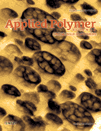Study on the preparation of Eu(Pht)3Phen/SBA-15 hybrids and photoluminescence properties of silicone rubber composites with the hybrids
Abstract
In this work, Eu(Pht)3Phen/SBA-15 hybrids were prepared by solution mixing and their morphologies and structures were characterized by X-ray diffraction (XRD), scanning electronic microscopy (SEM), nitrogen adsorption–desorption and transmission electronic microscopy (TEM). The results showed that Eu(Pht)3Phen was successfully incorporated into the channels and assembled onto the surface of SBA-15 and the long range ordered structure of SBA-15 was preserved. The silicone rubber composites with Eu(Pht)3Phen/SBA-15 hybrids were obtained by mechanical blending, and their morphologies and photoluminescence properties were studied. The results showed that the photoluminescence intensities of the composites with the hybrids increased as the content of the hybrids increased. The composite with the hybrids showed higher photoluminescence intensity and longer lifetime compared to the silicone rubber compounded with Eu(Pht)3Phen (Eu(Pht)3Phen/silicone rubber composite), Eu(Pht)3Phen and SBA-15 ([Eu(Pht)3Phen+SBA-15]/silicone rubber composite). Judd-Ofelt theory was used to investigate the local environment of Eu3+ ions in the silicone rubber composites. The photoluminescence quantum efficiency of the silicone rubber composite with Eu(Pht)3Phen/SBA-15 hybrids was calculated to be 31.0%, higher than that of Eu(Pht)3Phen/silicone rubber composite (26.4%) and [Eu(Pht)3Phen+SBA-15]/silicone rubber composite (25.4%). The enhancement in photoluminescence intensity and increase in lifetime and photoluminescence quantum efficiency could be attributed to the rigid structure of SBA-15 which reduced the nonradiative transition rate and the improvement of the dispersion of the hybrids in the composites. © 2012 Wiley Periodicals, Inc. J. Appl. Polym. Sci., 2013




